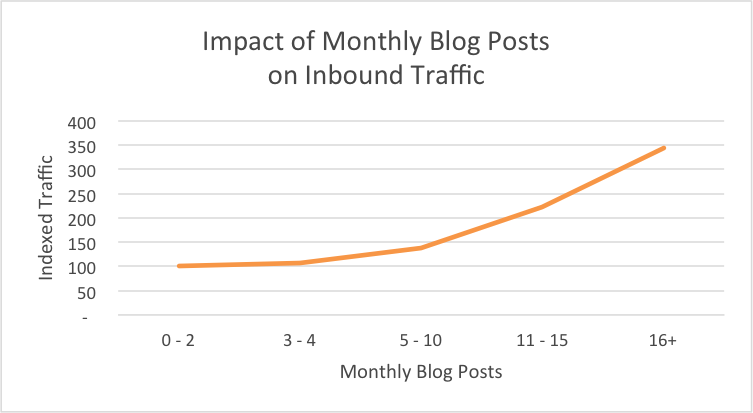10 point checklist: How to write – the inbound way
There is actually a separate way to write when you are working with inbound marketing. Here are a checklist teaching you all about how to write for inbound.
1. Write for your persona
Don’t write for an entire target group or several personas at the same time. Focus on one persona at a time. Why? There’s several reasons:
- You need to solve this exact persona’s challenge – not everyone’s challenges at the same time
- Talk the same language as your persona does: Are they technical, do they have a sense of humour or is this person more the serious kind? What kind of words do this person use? Perhaps most importantly: Are you using the right keywords in your content so that your persona can easily find you in the search engines?
- Make it more personal and relevant by using references and language that really triggers this specific persona
2. Solve the right problems at the right places in the buyer’s journey
We all go on a little journey when we are buying something that costs a little more than a pint of milk. This is what the journey looks like:
- Awareness: the lead is experiencing a problem that they need to solve
- Consideration: the lead has defined their problem and is actively looking for a solutions
- Decision: the lead is ready to choose the best solution and the best provider
This is why it is a good idea to think of “the funnel” to make sure that you are answering the questions to the right persona at the different stages in their buyer’s journey. The funnel can be split in three:
- Top of Funnel: Help the persona identify the reason they are experiencing a problem
- Middle of Funnel: Help the persona find a solution
- Bottom of Funnel: Help the persona understand that your company has the best solution – or not
To lead a persona through the entire buying process with helpful content you’ll need to create content for all of these three stages.
3. Write with the purpose of educating rather than selling
Inbound marketing is all about helping a person through the buying process instead of selling. Yes, the content will eventually lead to your sales team closing more deals but there’s a huge difference in screaming “Look at our products, we’re simply the best!” and “Hello there! It looks as though you might be experiencing some challenges that you want to solve. Here’s how it can be solved, and why this solution might be better for you than other solutions.”
Answering these questions will also help your company come across as honest, open and willing to help. This builds trust which in turn makes it more likely that they will buy your product or service.
4. Be creative!
There’s no way to sugar coat this: Inbound content needs to be appealing and interesting to the extent that people can’t keep their hands of the link when they see the title and description (even if they want to).
Since you are attracting people with the content rather than throwing it out at random people, you need to know who you are writing to, what that person cares about and what kind of content they usually read. And then be the best at creating great content for this person!
5. Strive to build trust in your content
You don’t simply want to help people make a good buying decision, you also want to establish yourself and your company as a thought leader. How? By creating trust through qualitative content.
Make sure to pay attention to other great sources of information and send your readers to them if you use a quote or some piece of content. With outgoing links you often will receive links back to your website from the one you linked to, which is highly appreciated by search engines like Google when they’re ranking sites for different search terms.
Google is also using metrics such as social links, shares and tagged content to rank pages in the search result.
So when you have a good idea for a blog post, start by doing research. Find out what’s already written and get inspired. Remember to not copy others, but to gather sources you can use and get information that is helpful. If you want to use someone else’s material, remember to link back to them.

6. Don't trust your gut feeling – trust your numbers
In marketing, it is quite normal to find companies that simply love to talk about themselves and their product without caring if anyone is actually listening. Don’t be like them.
Your content should be a pure reflection of what your readers have shown most interest in, and not just what your boss wants the world to know about your company and your products.
Pay close attention to which blog posts that get the most traffic, which one converts the best and last, but not least: which premium content gets you the most sales qualified leads (or even customers).
7. Care about keywords
A keyword is simply a word or phrase that people search for online. With over two trillion searches being done each year, ignoring the phrases people search for when it comes to your industry can be a huge missed opportunity.
Actually SEO leads have a 14.6% close rate, while outbound leads (such as direct mail or print advertising) have a 1.7% close rate (source). Do some research on the keywords people are looking for and the language your ideal persona uses.
Working those words into your content will greatly help your inbound marketing efforts.
8. Remember that your content needs to convert
Your content can be amazing and get thousands of clicks but if it doesn’t convert, it doesn’t work. There should always be a point of conversion in a blog post or premium content so that you can lead the reader to the next step.
If the conversion rate is poor, the content is probably not a match for that call-to-action. The CTA should be a natural second step for the reader, and if it isn’t, you’ll need to do some thinking.
9. Write and publish consistently
Don’t settle for one blog post every other month. One of the reasons inbound marketing can make your blog and website a leads generating machine is because the strategy requires you to build a bank of content that is helpful for your prospects.
Companies that published 16+ blog posts per month got almost 3.5X more traffic than companies that published between 0 - 4 monthly posts.

10. Plan your content
It’s important to have a calendar. The publishing calendar will give you a overview of the status of a post, who’s responsible, due date, who’s the author, which funnel the post belongs to, the title etc.
The publishing calendar will also help you see clearly if you have a balance in topics and formats on your blog.
Download: 10 content marketing strategies for 2019
Last but not least, what people tend to think is the most difficult part of the process is to come up with ideas for blog posts. What you should try to do is to think about what you customers usually ask you about.
Try to set yourself in their mindset and write down questions. Then make a title out of that. If you need some inspiration you can ask you sales team what your customers usually ask them about.
Real Growth. Real Impact.
HubSpot for startups: Leveraging the platform and unlocking growth w. Ragini Campion
Making AI adoption not a big deal with Mike Kaput from The AI Show
HubSpot's Spring Spotlight 2025 was not what we expected
The Power of Community in Marketing
The Return of Human Marketing in an Automated Age | Avidly Talks
How to make change projects a success - Change management tactics
How to prompt AI for great creative ideas
See why enterprises choose Avidly
Let’s build your HubSpot success story
Compelling final call to action - with accompanying link to Contact page








